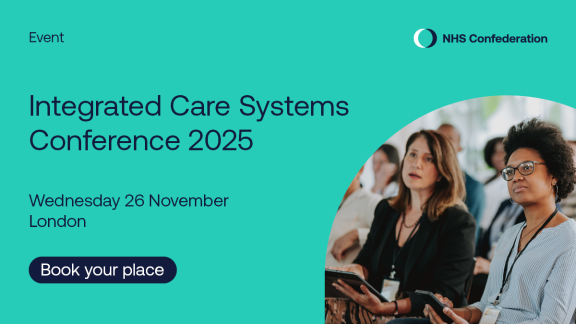If you can’t navigate an integrated care system, it isn’t a system

With every area of England now covered by an integrated care system, GP Helen Davies considers why the measurement of their success must be what service users experience.
Integrated care systems (ICSs) herald an NHS era where different provider organisations work together to redesign and integrate care. The concept is inspiring, but the measure of success will be whether the resulting service looks and feels integrated to the user. The danger is that the inherent conservatism in policy change may lead to a situation where organisations merely integrate at the margins and are bound together only by a common letterhead.
Revolutionising patient experience and delivering the intended operational efficiencies demands integration like we actually mean it. ICSs are being designed to address the needs of the whole population – central to this is the need for these systems to be visible and navigable by everyone. I listened to a workshop where a service user stopped the debate by saying: “An integrated service can only make that claim when those most in need feel their care is both personalised and joined up.”
Easy, seamless and safe
The new joined-up way of working presents a huge opportunity to do things differently; to put together an end-to-end personalised care journey. The route through the system needs to be easy, seamless and safe for both the user and the resulting care record.
There is a risk that unless all users of the system are provided with an accessible ‘map’, we may end up with a modern equivalent of the inverse care law first described in primary care by Julian Tudor Hart – an inverse navigation law. We need to ensure that we avoid compounding inequalities and digital exclusion for the most vulnerable groups in our population.
I met Tudor Hart when I was a GP trainer. What was remarkable about him was his optimism that we could find solutions to these challenges by joint endeavour. His wise voice is resonant in the current policy discourse. There are a set of enabling capabilities an ICS requires to achieve this:
- facilitating easy and secure access
- ensuring visibility of available services
- offering a variety of consultation options
- supporting professional conversations to guide better care
- enabling the safe handover of patients between professionals and organisations.
We need to design all this by putting the patient in the driving seat, so that they are actively contributing to and navigating their care, not being a parcel ‘passively posted’ around the system.
What’s the story?
Creation of an effective navigation system will be challenging. Its development needs to start with the core principles of a human-centred design and the application of a creative mindset. I love the quote: “Every great design begins with an even better story.” Lorinda Mamo, Designer
But what is the integrated care story we all aspire to? We are at the threshold of a transformation in the efficiency, awareness and responsiveness of the care system, and an expansion of user friendly, individualised and participative user experiences. We have an opportunity for the system to be visible to citizens, but also for the system to be enabled to ‘see’ the individual.
The system can create a closed learning loop to drive systematical service improvement and ongoing re-design. Working with data and users in and of the system, using design-thinking methods to focus on problems, articulate them effectively and quickly generate solutions.
Make it personal
But we need to hold our solutions lightly – what is needed, wanted and acceptable by users will inevitably change over time. This is the world of complex adaptive systems that need to iterate to survive. The system needs to be continually modified as the appetite and expectation of the population will change with societal norms and events – as COVID-19 has so clearly demonstrated. This is a not a time for ‘fluffy’ design trends – this is about hard-nosed delivery, rooted in user-centred experience and the critical measurement of outcomes.
Our experience of personalisation in other aspects of our lives sadly lags behind healthcare. It seems there is more effort put into selling us things than trying to keep us well. Most of the major retail digital platforms send targeted information based on sophisticated user profiling.
A similar process could use criteria to dynamically identify an individual’s needs and match to the most appropriate services. We need to think beyond traditional healthcare in this regard using statutory and non-statutory services, raising our vision beyond the traditional supply of services, to the untapped capacity in our communities.
Think for a moment about how we all now find our way around using satellite navigation – a comparable assisted navigation process is needed in health and social care. This is beyond simple search engines: this is about creating an interactive interface with the care system that can cater for individual needs and preferences.
Design with intent
The ICS policy heralds the much-needed pivot to align health, social and voluntary organisations to deliver population outcomes. It will result in a system of magnificent complexity and, as long as that complexity can be navigated, it is a time of great opportunity. We should, however, design with intent to avoid leaving behind the segments of our populations most in need of this new joined-up and personalised version of care.
Dr Helen Davies is a GP clinical lead for community and population health management at Calderdale Clinical Commissioning Group. Follow her on Twitter @HelenDa21136593 and connect with Helen on LinkedIn.
References
NHS England and NHS Improvement, (2019) Designing integrated care systems (ICSs) in England
Ku, B and Lupton, E, (2020) Health Design Thinking. The MIT Press.
Hart, JT, (1971) The inverse care law. Lancet. 1971 Feb 27;1(7696):405-12. doi: 10.1016/s0140-6736(71)92410-x. PMID: 4100731.



